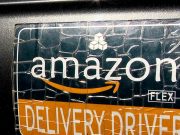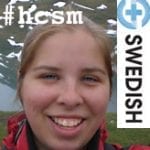 On an iconically overcast morning on Seattle’s First Hill, four doctors inside Swedish Hospital’s Orthopedic Institute were preparing to perform a state-of-the-art partial knee replacement on a 70-year old patient. One of the surgeons would not be operating on the patient but rather moderating the procedure online. Online, that is, until the pipeline between the Swedish “OR” and the Internet went offline.
On an iconically overcast morning on Seattle’s First Hill, four doctors inside Swedish Hospital’s Orthopedic Institute were preparing to perform a state-of-the-art partial knee replacement on a 70-year old patient. One of the surgeons would not be operating on the patient but rather moderating the procedure online. Online, that is, until the pipeline between the Swedish “OR” and the Internet went offline.
A webcast, surgical demonstration had been in the planning stages for weeks to be streamed live over the Internet via the Ustream service Thousands of onlookers had been invited to take a virtual, front row seat, the first of whom were beginning to show up.
Suddenly the normally fluid Ustream video signal had become the driest spot in the Puget Sound. In place of the camera’s live data flow, a static notice appeared on the monitor — “Undergoing Scheduled Maintenance.”
Dana M. Lewis, a social media specialist, had to wonder if she was confronting the epic “Fail Whale” of online ignominy that afflicts every new media professional at least once in their careers. Could this be happening before her eight month anniversary of helping to run social media for the Swedish Medical Center? Hired for her distinguished track record as a health care social media pioneer, her mettle was being tested. How would she respond?
 Swedish had already scaled a number of technical heights that garnered social media attention. Dana was one of the digital sherpas who climbed half way up Mount Rainier with a modem-tethered satellite phone and dispatched a live Web stream in order to bring attention to organ transplants. Swedish had also cybercast the world’s first all night Sleep Study webcasting over 12 hours of continuous video and hosting thousands of viewer comments on what constituted a good night’s sleep. Dana had made a mountainous star trek but could not explain the outage of the Ustream website. Worse still, there was no phone contact to reach Ustream in real time.
Swedish had already scaled a number of technical heights that garnered social media attention. Dana was one of the digital sherpas who climbed half way up Mount Rainier with a modem-tethered satellite phone and dispatched a live Web stream in order to bring attention to organ transplants. Swedish had also cybercast the world’s first all night Sleep Study webcasting over 12 hours of continuous video and hosting thousands of viewer comments on what constituted a good night’s sleep. Dana had made a mountainous star trek but could not explain the outage of the Ustream website. Worse still, there was no phone contact to reach Ustream in real time.
With a precision rivaling her medical counterparts, Dana conducted her own transplant procedure, replacing the defunct Ustream embedded player on the Swedish Medical Center landing page with new code from an alternate service known as Justin.tv. Fingers flying across the keyboard to activate the Justin.tv account, Dana quickly configured the new settings. While the surgical clock clicked down, the video signal came back up, filling the pipeline with video-animating broadband. “Please refresh your browsers,” Dana texted into the Web page’s built-in chat window. Her tweet reached out to the thousands of visitors who were gathering around their computers across the US and from dozens of countries around the world.
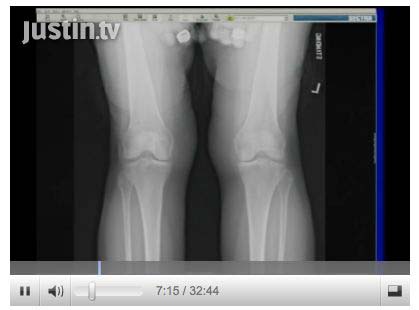 The operation, led by surgeon Sean Toomey, MD, and moderated by James Crutcher, MD, was a success both medically and social media-wise. You can view the 4-1/2 hour archived recordings here: http://www.justin.tv/swedishseattle/b/281608369 and read the Twitter commentary on http://search.twitter.com/search?q=%23livekneesurgery
The operation, led by surgeon Sean Toomey, MD, and moderated by James Crutcher, MD, was a success both medically and social media-wise. You can view the 4-1/2 hour archived recordings here: http://www.justin.tv/swedishseattle/b/281608369 and read the Twitter commentary on http://search.twitter.com/search?q=%23livekneesurgery
Unflustered by the technical speed bumps and detours on her journey, Dana exudes a similar sense of confidence and optimism when she talks about the other symptoms of these early, yet vital and formative, days in the evoluton of health care and social media. As our interview with the new Seattle resident and champion for health and social media, and as her colleague and mentor, Swedish Health Services’ Communications Director, Melissa Tizon, will attest, a “can do” attitude is practically a prerequisite to getting the job done. “Too many think only of what can’t be done in health care and social media,” says Lewis. “The time has come to imagine what can be done!”
We met with Dana just a day after the heroic streaming video rescue effort and a few days after she returned from Austin, Texas, where she joined in a brand new health track she helped to create at the South by Southwest Interactive (SXSW) Conference. Lewis has been nationally recognized as the founder and moderator of “#HCSM” (Healthcare Communications & Social Media) on Twitter. “#HCSM” provides health-care professionals, students, patients and communicators a free and easily accessible online medium to discuss the role social media plays in healthcare. Our discussion starts now.
Seattle24x7: Dana, in addition to the recent Webcast of live knee replacement surgery online, Swedish Medical Center has made history with several other online events including an online Sleep Study and a mobile Webcast from Mount Rainier. What can you tell us about them?
Dana: Our sleep study attracted a very large audience both because we streamed live for 12 hours, making it the longest sleep study ever broadcast online, and because so many people are interested in sleep issues. I think we had 10,000 people online in a 12-hour space who were interacting live with us.
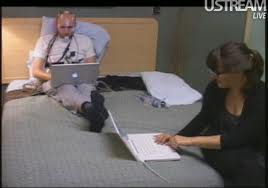 That’s a sizable number for watching someone who is asleep. Of course, not only did we have an infra-red camera on the patient, but also a split-screen with the doctors and sleep techs in a separate room all night long. These experts would talk about the results from the study as they came in, showing the sleep patterns being monitored on the screen, and answering lots of questions that came in from the viewers. Viewers would ask, ‘What is a Sleep Study really like?’ ‘What is sleep apnea?’ ‘What are these machines measuring?’
That’s a sizable number for watching someone who is asleep. Of course, not only did we have an infra-red camera on the patient, but also a split-screen with the doctors and sleep techs in a separate room all night long. These experts would talk about the results from the study as they came in, showing the sleep patterns being monitored on the screen, and answering lots of questions that came in from the viewers. Viewers would ask, ‘What is a Sleep Study really like?’ ‘What is sleep apnea?’ ‘What are these machines measuring?’
While the patient slept, the cameras would check in on him periodically, pulling back up to full screen, but the real attraction was that we had our sleep doctors talking with people and providing useful health information when people needed it the most – at night. There have been other hospitals and health groups that have done live events. But to my knowledge, this was the longest one of its kind.
Seattle24x7: Besides the longest online video stream, you’ve also done what could be the highest elevation?
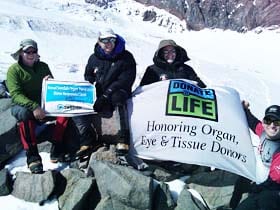 Dana: Yes, we also did a webcast with a group of doctors from our Transplant program who climbed Mount Rainier. This is the second time they’ve done the climb to raise awareness, and to encourage people to talk about transplants, think about their preferences for being a donor, and have that conversation with their family.
Dana: Yes, we also did a webcast with a group of doctors from our Transplant program who climbed Mount Rainier. This is the second time they’ve done the climb to raise awareness, and to encourage people to talk about transplants, think about their preferences for being a donor, and have that conversation with their family.
Seattle24x7: How did that remote Webcast originate?
Dana: The doctors came to us and said, “We’d love to do something with social media, because we’ve heard that it can reach many people. What can we do? Is there anything we can do from the mountain?” So we put our heads together and we created this solar-powered “social media backpack” — a lightweight backpack with a webcam, a microphone, and a small laptop. We used Ustream, and we streamed back and forth between two locations to show the doctors up on the mountain. Back here at Swedish, we hosted a parallel live streamed conversation around organ donation. We had several hundred people interact with us and show their support for organ donation.
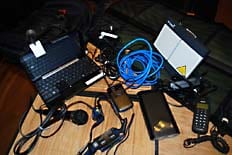
Seattle24x7: That sounds like a world record achievement of some sort.
Dana: Hmm, a live stream from the highest point of the world, perhaps?
Seattle24x7: Tell us how you got started in social media and healthcare.
Dana: I started in social media years ago when I was still an undergraduate at the University of Alabama because I had not only consulted on using social media for health care, but I also used it personally. I knew I wanted to work in the field full time and I thought to myself there’s no reason I can’t collaborate with other professionals and talk about what’s going on around the country. You know, why do I need to wait until I’m out of school? So I got together with some people that I had talked to on Twitter and said, let’s just have a conversation and let’s use a [Twitter] hash tag so we can track it and archive it so that if anyone else wants to join in, there will be no barriers to the conversation whether you’re a college student, a doctor, a hospital marketer, or anyone. That’s how the #HCSM chat group was started.
Seattle24x7: Your #HCSM hash tag has become the largest discussion group on Twitter for health care and social media.
Dana: It’s been extremely gratifying to see #hcsm grow from a one-time chat to a large, international community. There have been 50,000+ uses of the hash tag in the past 4 months alone. And you can’t really measure the direct power of how many people it has influenced, because people who may not be participating directly, who are “lurking,” can take away the ideas and the excitement and the energy and do something with it. That’s the true power of #hcsm.
Seattle24x7: Twitter is accessible, of course, 24/7/365, but the HCSM discussion is also live every week?
Dana: Yes, it’s every Sunday night and that has become fairly well known, both inside and outside of the healthcare industry. During the one hour period, you’re in the live conversation. So, during the week, there might be a tweet every few minutes, or a couple times per hour, but on Sunday night, we’ll get 1200-1500 tweets in a single hour. So you can imagine, that’s several tweets per minute that are just flying down the screen. It’s a bit of an adjustment if you watch it live for the first time. To participate, you go to search.twitter.com. Put in the hashtag #hcsm, and you’ll see the conversation that’s happening. Whether you’re a student, a doctor, a patient, or anyone who’s traditionally felt excluded from any health care conversations, you can be included here.
Seattle24x7: A question that seems to be on everyone’s minds these days is how health care professionals can engage in social media when there are concerns for dispensing information that might be taken literally as a diagnosis or, for patients, that might violate privacy or patients’ rights? What do you advise about these concerns and have they had a chilling effect on doctor’s actively participating in health care and social media?
 Dana: It’s a great question. Even patients who are blogging for themselves often times put up disclaimers stating “I’m not a medical professional, this is my personal anecdotal experience and anything that works for me may or may not work for you.” So I think everybody is feeling that responsibility. I think the point to understand is that you can still provide general health information questions as a physician or a health care worker without making an individual diagnosis. The general information can be very useful even though the health care provider is NOT saying, “here’s what you should do as an individual.”
Dana: It’s a great question. Even patients who are blogging for themselves often times put up disclaimers stating “I’m not a medical professional, this is my personal anecdotal experience and anything that works for me may or may not work for you.” So I think everybody is feeling that responsibility. I think the point to understand is that you can still provide general health information questions as a physician or a health care worker without making an individual diagnosis. The general information can be very useful even though the health care provider is NOT saying, “here’s what you should do as an individual.”
For example, after the recent natural disasters in Japan, I went online and asked a question to an endocrinologist about the radiation scare and what should I know. Did she have any links? Well, she sent me a link with resources that was helpful to read. But at the end of the day I’m going to go back to my doctor if I have a personal concern or specific question regarding my health. People online are there to share health information, to network, to build relationships, and to contribute to the community, but not to make individual diagnoses.
Seattle24x7: So there’s no reason to feel as if you can’t talk about health issues online, as a patient or as a health care giver? The attitudes have changed!
Dana: Right, I think now any disclaimer is understood or expressed immediately, and then the conversation continues without a hitch. Also, there’s a difference, for example, if I ask somebody, how much Vitamin D should I take? They’re not going to say, “You should take 5,000 milligrams a day”. They’re more likely to say, “Here are some articles pointing to research that indicate 2,000 milligrams is safe”. Or, “Usually, I tell my patient 4,000 mg but you should talk to your doctor and ask him what he recommends for you.” It’s very easy to point to resources and say, here’s generally what’s done in the community, here’s what the research said, but talk to your doctor.
Seattle24x7: So it’s making helpful references and connecting the dots as opposed to a doctor or advisor making a definitive statement about what you should do.
Dana: Right. Nobody would make a direct, declarative statement in social media or otherwise. Again, it’s the same thing as real life. We encourage people to think before they tweet or post and to use common sense.
Seattle24x7: And doctors are following these guidelines?
Dana: The American Medical Association came out with social media guidelines in the fall. One of the most contentious points among physicians was that it basically told them to report fellow physicians’ online activity. I think the idea of a peer review was awkward. But the general idea is physicians should help educate and promote the conversation about what you should and should not be doing online. It’s not policing, but setting a high standard for yourself and for the community.
Seattle24x7: I would imagine a key concern is providing patients with credible sources of information and consumers not being mislead?
Dana: I think physicians will play a key role in helping patients and consumers access credible health info. Even if they don’t use social media, they need to ask their patients, “I know you’re going online, 80% of people do it. Where do you get your information? What are you looking for? Do you know which sites are credible in health care? Can I help you find a good online resource or community? Do you know when you’re sharing your health information?”
Often times, when I give a presentation to a general audience, they may not realize they are engaged in social media in the first place. I’ll ask, how many of you use social media for health care? Maybe two or three people out of 100 will raise their hands. And then I say, “How many of you have Googled about cold and flu symptoms?” A lot of people raise their hands. And I’ll ask, “how many people have watched a YouTube video related to some kind of health issue?” Almost everybody raises their hand. Well, see, you’re using social media for health care. You just may not be aware about what kind of information you’re putting out there.
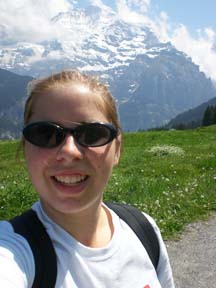 The same thing applies when you post a Facebook update about how a family member is sick: you’re using social media for healthcare. As consumers and patients, I think it’s really important for us to consider what information we’re putting online for our own safety and well-being. Again, it’s relevant to more than healthcare, but it’s a huge conversation that needs to be happening regarding online activity.
The same thing applies when you post a Facebook update about how a family member is sick: you’re using social media for healthcare. As consumers and patients, I think it’s really important for us to consider what information we’re putting online for our own safety and well-being. Again, it’s relevant to more than healthcare, but it’s a huge conversation that needs to be happening regarding online activity.
Seattle24x7: Swedish is co-hosting a conference on Social Media this April 13-15 entitled “The Role of Social Media in Engaging Patients, Employees and the Media.” What is being covered?
Dana: The conference covers all the bases, but what I think is fantastic about it is that it goes well beyond the basic “how-to’s” of Facebook, YouTube, and Twitter. We’re at the point now in health care where we have to look beyond the technology and understand how can we engage with people? What I’m looking forward to the most are several sessions talking about how to truly engage with a large patient population around the issues of interest to those patients. Where are your audiences? How can you engage with them? What are the most effective strategies and tips? This is especially useful for not only engaging with people outside of your organization, but empowering and engaging employees inside your organization. Health care employees use social media for health care, too!
Seattle24x7: You just got back from South by Southwest and one of the premier gatherings there devoted to health care and social media?
Dana: I’m proud to say that I was involved in co-founding that health track, and making it part of this year’s proceedings
Last year we had an event that was called an Unconference because SXSW wouldn’t acknowledge health as a key topic area of interest.
Seattle24x7: How were you able to get SXSW to include it?
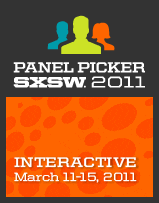
Dana: Well, it started by submitting our ideas for panels to SXSW last year. Only one or two actual health panels got picked by SXSW last year out of tons submitted, so we were pretty surprised. We reached out to them at that time and said, can you do something more with Health? It’s such a hot topic. They told us no, so we decided to do a one day conference ourselves ahead of SXSW. That was called the “Unconference”, or “South By Social Health” (SXSH). They noticed the interest and success and acknowledged that they could (and should) be doing more. They created an advisory board which led to 23 sessions on a full health track this year, many of which were standing room only.
Seattle24x7: How would you compare the social media initiatives in Seattle health care compared to other parts of the country?
Dana: I would say that in terms of technology and social media, Seattle has the rest of the country beat. That’s one of the reasons I felt so comfortable moving here. Even before I arrived, I got connected with a huge group in the Seattle community very early through Twitter. In terms of health care, Swedish has been cited, along with The Mayo Clinic, as one of the very top innovators in the country.
For example, for a conference we did in October, we had people participating from several other health organizations in the area. This spring, when I led a webinar on HIPPA, and privacy, and Health IT related to social media in healthcare, we had somebody from almost every health organization in the region join the conversation, ask questions and share knowledge. I don’t know that that happens everywhere like it does here. I think the potential for collaboration and partnering with other organizations here is top-notch. [24×7]






